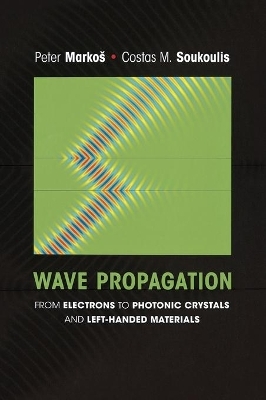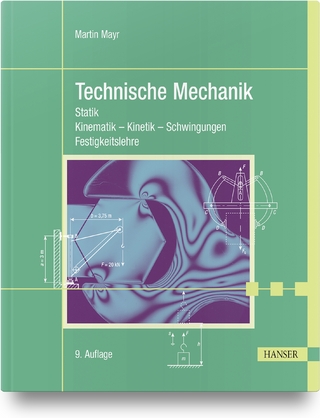
Wave Propagation
Princeton University Press (Verlag)
978-0-691-13003-3 (ISBN)
This textbook offers the first unified treatment of wave propagation in electronic and electromagnetic systems and introduces readers to the essentials of the transfer matrix method, a powerful analytical tool that can be used to model and study an array of problems pertaining to wave propagation in electrons and photons. It is aimed at graduate and advanced undergraduate students in physics, materials science, electrical and computer engineering, and mathematics, and is ideal for researchers in photonic crystals, negative index materials, left-handed materials, plasmonics, nonlinear effects, and optics. Peter Markos and Costas Soukoulis begin by establishing the analogy between wave propagation in electronic systems and electromagnetic media and then show how the transfer matrix can be easily applied to any type of wave propagation, such as electromagnetic, acoustic, and elastic waves. The transfer matrix approach of the tight-binding model allows readers to understand its implementation quickly and all the concepts of solid-state physics are clearly introduced.
Markos and Soukoulis then build the discussion of such topics as random systems and localized and delocalized modes around the transfer matrix, bringing remarkable clarity to the subject. Total internal reflection, Brewster angles, evanescent waves, surface waves, and resonant tunneling in left-handed materials are introduced and treated in detail, as are important new developments like photonic crystals, negative index materials, and surface plasmons. Problem sets aid students working through the subject for the first time.
Peter Markos is a researcher at the Institute of Physics at the Slovak Academy of Sciences. Costas M. Soukoulis is Distinguished Professor of Physics at Iowa State University and senior physicist at Ames Laboratory. His books include "Photonic Band Gap Materials" and "Photonic Crystals and Light Localization in the Twenty-First Century".
Preface ix Chapter 1: Transfer Matrix 1 1.1 A Scattering Experiment 2 1.2 Scattering Matrix and Transfer Matrix 3 1.3 Transmission and Reflection Amplitudes 10 1.4 Properties of the Transfer Matrix 12 1.5 Supplementary Notes 19 1.6 Problems 24 Chapter 2: Rectangular Potentials 28 2.1 Transfer Matrix 29 2.2 Transmission Coefficient: E > V0 32 2.3 Tunneling: 0 V0 38 2.4 Current Density 42 2.5 Bound States: V0 0 45 2.6 Inverse Problem for Rectangular Potential 47 2.7 Problems 49 Chapter 3: delta -Function Potential 56 3.1 Single delta-Function Potential 56 3.2 Two delta-Function Repulsive Potentials 60 3.3 Bound States of Double delta-Function Attractive Potentials 62 3.4 N Identical delta-Function Barriers 64 3.5 Supplementary Notes 68 3.6 Problems 69 Chapter 4: Kronig-Penney Model 74 4.1 The Periodic Model 75 4.2 Allowed Energy Bands 76 4.3 The Density of States 81 4.4 Wave Function 83 4.5 Single Impurity 84 4.6 N delta-Function Barriers versus Infinite Kronig-Penney Model 87 4.7 Supplementary Notes 88 4.8 Problems 91 Chapter 5: Tight Binding Model 98 5.1 Periodic Model 100 5.2 The Transfer Matrix 104 5.3 Transmission Coefficient 106 5.4 Single Impurity 107 5.5 Transmission through Impurities 108 5.6 Coupled Pendulum Analogy of the Tight Binding Model 111 5.7 Problems 114 Chapter 6: Tight Binding Models of Crystals 120 6.1 Periodic One-Dimensional System with Two Different Atoms 120 6.2 Periodic Model with Different Distances between Neighboring Atoms 125 6.3 Periodic One-dimensional System with Two Different Atoms and Spatial Period l = 4a 126 6.4 Reduced Zone Scheme 129 6.5 Problems 130 Chapter 7: Disordered Models 137 7.1 Random Tight Binding Model 138 7.2 Random Kronig-Penney Model 150 7.3 Supplementary Notes 159 7.4 Problems 168 Chapter 8: Numerical Solution of the Schrodinger Equation 173 8.1 Numerical Procedure 173 8.2 Accuracy of Numerical Data 174 8.3 Numerical Data for Transmission 177 8.4 Problems 179 Chapter 9: Transmission and Reflection of Plane Electromagnetic Waves on an Interface 181 9.1 Plane Wave at the Interface 181 9.2 Transmission and Reflection Coefficients 184 9.3 Interface between Two Dielectric Materials 189 9.4 Interface between a Dielectric Material and a Metal 190 9.5 Total Transmission 195 9.6 Total Reflection 198 9.7 Problems 200 Chapter 10: Transmission and Reflection Coefficients for a Slab 205 10.1 Transmission and Reflection Amplitudes: TE and TM modes 206 10.2 Dielectric Slab Embedded in Vacuum 209 10.3 Transmission through a Metallic Slab 220 10.4 Problems 223 Chapter 11: Surface Waves 225 11.1 Surface Waves at the Interface between Two Media 226 11.2 Surface Modes on a Slab 233 11.3 Experimental Observation of Surface Waves 237 11.4 Problems 241 Chapter 12: Resonant Tunneling through Double-Layer Structures 243 12.1 Transmission through Two Dielectric Layers 243 12.2 Transmission through Two Metallic Layers 246 12.3 Problems 248 Chapter 13: Layered Electromagnetic Medium: Photonic Crystals 249 13.1 Photonic Crystals: Infinite Periodic Layered Medium 250 13.2 Periodic Arrangement of Dielectric Layers 252 13.3 Band Structure of Photonic Crystals 254 13.4 Coupling to a Finite Photonic Crystal 258 13.5 Layered Dispersive Media 263 13.6 Kronig-Penney Model of a Photonic Crystal 269 13.7 Problems 271 Chapter 14: Effective Parameters 275 14.1 Effective Parameters of a Layered Medium 276 14.2 Retrieval Procedure 279 14.3 Alternating Layers with Negative Permittivity and Negative Permeability 282 14.4 Problem 285 Chapter 15: Wave Propagation in Nonlinear Structures 286 15.1 Single delta-Function Layer of a Nonlinear Dielectric 286 15.2 Nonlinear Kronig-Penney delta-Function Model 290 15.3 Problems 296 Chapter 16: Left-Handed Materials 298 16.1 Electromagnetic Properties of Left-Handed Materials 299 16.2 Transmission through a Slab of Left-Handed Material 303 16.3 Structure of Left-Handed Materials 309 16.4 Problems 317 Appendix A: Matrix Operations 321 A.1 The Determinant and the Trace of the Matrix 321 A.2 Inverse, Transpose, and Unitary Matrices 322 A.3 Eigenvalues and Eigenvectors 324 A.4 Similarity Transformations 324 A.5 Degeneracy 325 Appendix B: Summary of Electrodynamics Formulas 327 B.1 Maxwell's Equations 327 B.2 Wave Equation 330 B.3 Group Velocity and Phase Velocity 331 B.4 Poynting Vector 333 B.5 Boundary Condition at an Interface 334 B.6 Permitivity and Permeability 335 B.7 Metals 337 Bibliography 341 Index 349
| Erscheint lt. Verlag | 21.4.2008 |
|---|---|
| Zusatzinfo | 75 line illus. 25 tables. |
| Verlagsort | New Jersey |
| Sprache | englisch |
| Maße | 178 x 254 mm |
| Gewicht | 907 g |
| Themenwelt | Naturwissenschaften ► Physik / Astronomie ► Mechanik |
| ISBN-10 | 0-691-13003-5 / 0691130035 |
| ISBN-13 | 978-0-691-13003-3 / 9780691130033 |
| Zustand | Neuware |
| Haben Sie eine Frage zum Produkt? |
aus dem Bereich


